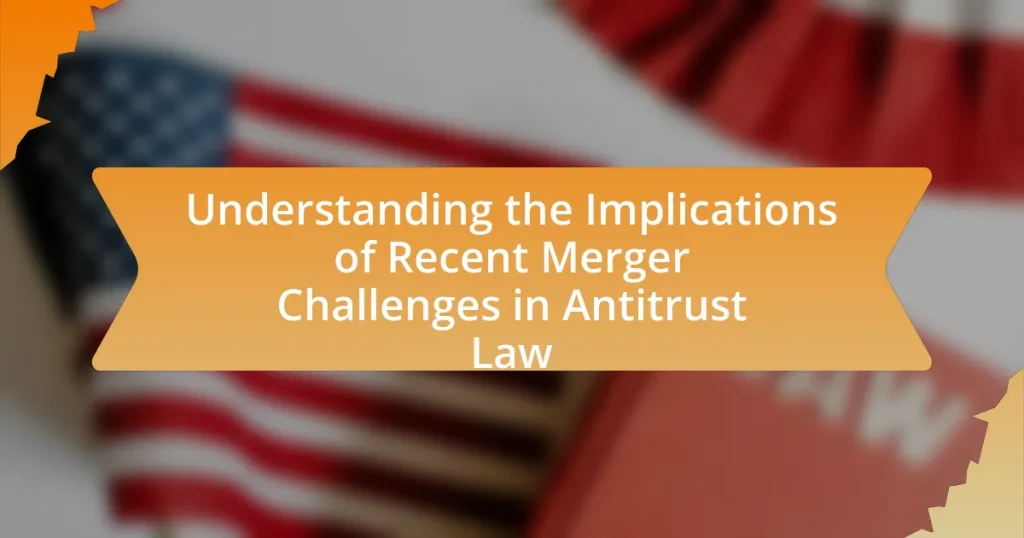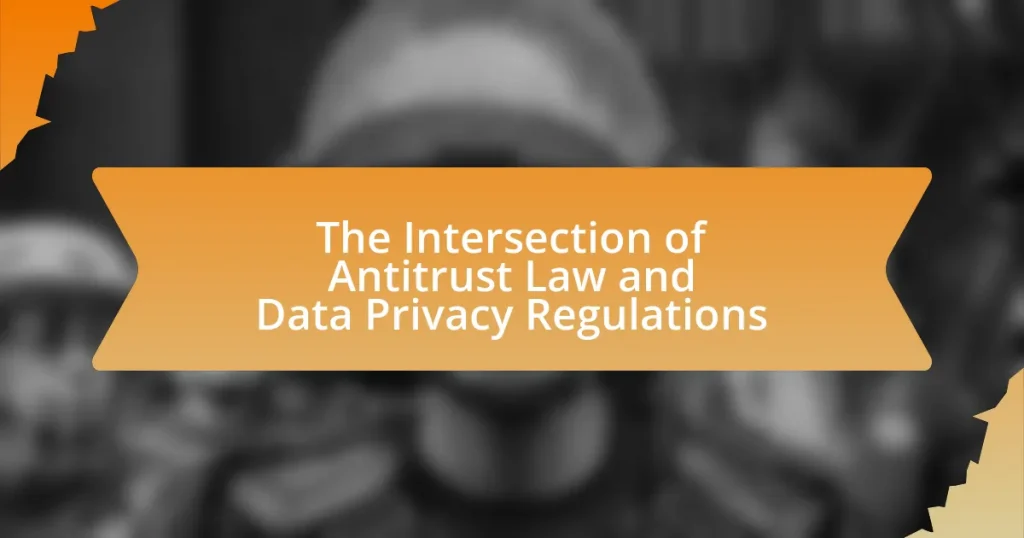The article focuses on the recent challenges in antitrust law related to mergers, highlighting increased scrutiny from regulatory bodies like the Federal Trade Commission (FTC) and the Department of Justice (DOJ). It discusses how recent mergers have impacted competition across various industries, exemplified by high-profile cases such as the attempted mergers of Nvidia and Arm, and AT&T and Time Warner. The article outlines the critical role of antitrust law in regulating mergers to prevent monopolistic behavior, protect consumer welfare, and maintain competitive markets. Additionally, it examines the evolving landscape of antitrust enforcement, the implications of legal precedents, and best practices for companies navigating merger assessments.

What are the Recent Merger Challenges in Antitrust Law?
Recent merger challenges in antitrust law primarily involve increased scrutiny from regulatory bodies regarding market concentration and competitive practices. For instance, the Federal Trade Commission (FTC) and the Department of Justice (DOJ) have intensified their reviews of proposed mergers, focusing on potential harms to competition, consumer choice, and innovation. In 2021, the Biden administration announced a new approach to antitrust enforcement, emphasizing the need to prevent monopolistic behaviors and protect smaller businesses. This shift is evidenced by high-profile cases such as the attempted merger between Nvidia and Arm, which faced significant opposition due to concerns over reduced competition in the semiconductor industry.
How have recent mergers impacted competition in various industries?
Recent mergers have significantly reduced competition in various industries by consolidating market power among fewer players. For instance, the merger between T-Mobile and Sprint in 2020 resulted in a reduction of the number of major wireless carriers from four to three, leading to concerns about higher prices and reduced service quality for consumers. Additionally, the merger of major food companies, such as Kraft Heinz and Unilever, has raised antitrust scrutiny due to potential monopolistic behavior that could limit choices for consumers and stifle innovation. These examples illustrate how mergers can create oligopolistic market structures, ultimately harming competition and consumer welfare.
What specific cases exemplify these merger challenges?
The specific cases that exemplify merger challenges include the proposed merger between AT&T and Time Warner, which faced scrutiny from the Department of Justice over concerns of reduced competition and increased consumer prices. Additionally, the merger attempt between Sprint and T-Mobile was challenged due to fears of market consolidation that could harm consumers. Both cases highlight the complexities of antitrust law as regulators assess the potential impacts on competition and consumer welfare.
How do these cases reflect broader trends in antitrust enforcement?
Recent merger challenges in antitrust law reflect a trend towards increased scrutiny of corporate consolidation and a shift in enforcement priorities. This trend is evidenced by the heightened focus on preventing monopolistic practices and promoting competition, as seen in cases like the blocked merger between AT&T and Time Warner, where regulators emphasized the potential harm to consumers and market dynamics. Additionally, the Biden administration’s antitrust policies signal a commitment to aggressive enforcement, aiming to address market concentration across various industries, including technology and healthcare, thereby reinforcing the importance of maintaining competitive markets for consumer welfare.
Why is antitrust law critical in regulating mergers?
Antitrust law is critical in regulating mergers because it prevents the formation of monopolies and promotes competition in the marketplace. By scrutinizing mergers, antitrust authorities assess whether a proposed combination would significantly reduce competition, leading to higher prices, reduced innovation, or inferior products for consumers. Historical cases, such as the 2018 AT&T and Time Warner merger, illustrate the importance of antitrust scrutiny; the Department of Justice challenged the merger on the grounds that it would harm competition and lead to higher consumer prices. Thus, antitrust law serves as a vital mechanism to ensure that mergers do not undermine market dynamics and consumer welfare.
What are the primary objectives of antitrust law?
The primary objectives of antitrust law are to promote competition, prevent monopolies, and protect consumer welfare. Antitrust laws aim to ensure that markets remain open and competitive, which fosters innovation and lowers prices for consumers. For instance, the Sherman Act of 1890 and the Clayton Act of 1914 serve as foundational statutes in the United States that prohibit anti-competitive practices such as price-fixing and monopolistic behavior. These laws are enforced by agencies like the Federal Trade Commission and the Department of Justice, which investigate and challenge mergers that may substantially lessen competition or create a monopoly.
How do these objectives relate to consumer welfare?
The objectives of recent merger challenges in antitrust law directly relate to consumer welfare by aiming to prevent anti-competitive practices that could harm consumers. These objectives focus on maintaining market competition, which ensures fair pricing, product quality, and innovation. For instance, the Federal Trade Commission’s guidelines emphasize that mergers should not substantially lessen competition or create a monopoly, as evidenced by cases like the blocked merger between AT&T and Time Warner, which was deemed likely to harm consumer choice and increase prices. Thus, the enforcement of these objectives is crucial for protecting consumer interests and promoting a healthy market environment.
What are the potential consequences of failing to address merger challenges?
Failing to address merger challenges can lead to significant legal and financial repercussions for companies involved. Specifically, companies may face antitrust lawsuits, resulting in costly litigation and potential fines, as seen in cases like the 2018 AT&T-Time Warner merger, where the Department of Justice sought to block the deal due to antitrust concerns. Additionally, unaddressed challenges can lead to operational disruptions, loss of market share, and damage to corporate reputation, as stakeholders may lose confidence in the company’s ability to navigate regulatory environments effectively. Ultimately, neglecting these challenges can hinder long-term strategic goals and diminish shareholder value.
How can unregulated mergers lead to monopolistic behavior?
Unregulated mergers can lead to monopolistic behavior by allowing companies to consolidate market power without oversight, resulting in reduced competition. When firms merge without regulatory scrutiny, they can eliminate rivals, control prices, and dictate market conditions, ultimately harming consumers. Historical examples, such as the 2000 merger between AOL and Time Warner, illustrate how unregulated mergers can create dominant entities that stifle competition and innovation. This consolidation can lead to higher prices and fewer choices for consumers, as the merged entity may prioritize profit over consumer welfare.
What are the economic implications for consumers and businesses?
The economic implications for consumers and businesses in the context of recent merger challenges in antitrust law include potential price increases and reduced competition. When mergers are allowed without stringent scrutiny, businesses may consolidate market power, leading to higher prices for consumers due to diminished competition. For instance, a study by the American Economic Association found that mergers in concentrated industries often result in price hikes of 5% to 10%. Additionally, businesses may face fewer choices in suppliers and products, which can stifle innovation and reduce overall market efficiency. Thus, the enforcement of antitrust laws aims to protect consumer interests and maintain a competitive marketplace, ultimately benefiting both consumers and businesses by fostering a diverse economic environment.
How do regulatory bodies assess merger challenges?
Regulatory bodies assess merger challenges by analyzing the potential impact of a merger on market competition. They evaluate factors such as market share, barriers to entry, and the likelihood of anti-competitive behavior. For instance, the Federal Trade Commission (FTC) and the Department of Justice (DOJ) in the United States utilize the Horizontal Merger Guidelines, which provide a framework for assessing whether a merger may substantially lessen competition or create a monopoly. These guidelines include quantitative measures, such as the Herfindahl-Hirschman Index (HHI), to evaluate market concentration levels post-merger. Historical cases, such as the merger between AT&T and Time Warner, illustrate how regulatory bodies scrutinize mergers based on their potential to harm consumers and stifle innovation.
What factors influence the decision-making process in antitrust cases?
The decision-making process in antitrust cases is influenced by several key factors, including market structure, competitive effects, and legal precedents. Market structure examines the number of competitors and the level of concentration within the industry, which can determine whether a merger may substantially lessen competition. Competitive effects analyze how a merger might impact prices, output, and innovation, with a focus on potential harm to consumers. Legal precedents provide a framework based on previous rulings, guiding how similar cases are evaluated. For instance, the U.S. Department of Justice and the Federal Trade Commission utilize the Horizontal Merger Guidelines to assess these factors systematically, ensuring that decisions align with established antitrust principles.

What are the Key Legal Frameworks Governing Merger Challenges?
The key legal frameworks governing merger challenges include the Clayton Act, the Hart-Scott-Rodino Antitrust Improvements Act, and the European Union Merger Regulation. The Clayton Act, enacted in 1914, prohibits mergers and acquisitions that may substantially lessen competition or tend to create a monopoly in the United States. The Hart-Scott-Rodino Act requires companies to file pre-merger notifications with the Federal Trade Commission and the Department of Justice, allowing for antitrust review before a merger can be completed. The European Union Merger Regulation governs mergers and acquisitions within the EU, assessing their compatibility with the internal market and preventing anti-competitive practices. These frameworks are essential for maintaining competitive markets and preventing monopolistic behaviors.
How do different jurisdictions approach antitrust law?
Different jurisdictions approach antitrust law through varying frameworks and enforcement mechanisms. For instance, the United States primarily employs a consumer welfare standard, focusing on the effects of business practices on consumer prices and market competition, as established in landmark cases like United States v. Microsoft Corp. In contrast, the European Union adopts a broader public interest approach, emphasizing market structure and competition, as seen in its rigorous scrutiny of mergers under the EU Merger Regulation. Additionally, countries like China have developed their own antitrust laws, such as the Anti-Monopoly Law, which reflects a unique blend of economic development goals and competition policy. These differences illustrate how cultural, economic, and legal contexts shape antitrust enforcement across jurisdictions.
What are the differences between U.S. and EU antitrust regulations?
U.S. and EU antitrust regulations differ primarily in their approach to market competition and enforcement mechanisms. The U.S. system, governed by the Sherman Act and the Clayton Act, emphasizes consumer welfare and economic efficiency, often allowing mergers unless they significantly reduce competition or create monopolies. In contrast, EU regulations, primarily under the Treaty on the Functioning of the European Union, adopt a broader public interest approach, considering factors like market structure and potential harm to competition, even if consumer prices do not increase. This difference is evident in the EU’s more proactive stance on preventing mergers that could harm market competition, as seen in cases like the blocked merger between Siemens and Alstom in 2019, which the EU deemed detrimental to competition despite potential efficiencies.
How do international agreements impact merger assessments?
International agreements significantly influence merger assessments by establishing common regulatory standards and frameworks that facilitate cooperation among countries. These agreements, such as the OECD Guidelines for Merger Assessments, promote consistency in evaluating mergers, which helps prevent anti-competitive practices across borders. For instance, the European Union’s Merger Regulation requires that mergers with a significant impact on competition within the EU be assessed, and this regulation aligns with international norms to ensure that member states coordinate their evaluations. This alignment reduces the risk of conflicting decisions and enhances the predictability of merger outcomes, ultimately fostering a more stable international business environment.
What role do economic analyses play in merger evaluations?
Economic analyses are crucial in merger evaluations as they assess the potential impact of a merger on market competition and consumer welfare. These analyses utilize quantitative methods to predict changes in market dynamics, pricing, and output levels, thereby identifying whether a merger could lead to anti-competitive behavior. For instance, the Horizontal Merger Guidelines issued by the Federal Trade Commission and the Department of Justice emphasize the importance of economic models in evaluating market shares and potential price increases resulting from mergers. By providing empirical evidence and theoretical frameworks, economic analyses help regulators make informed decisions about whether to approve or challenge proposed mergers, ensuring that they align with antitrust laws aimed at promoting fair competition.
How are market shares and competitive effects measured?
Market shares are measured by calculating the percentage of total sales in a market that is attributed to a particular company, often using data from sales reports or industry analyses. Competitive effects are assessed through various methods, including the Herfindahl-Hirschman Index (HHI), which quantifies market concentration by summing the squares of the market shares of all firms in the market, and by evaluating price changes, consumer choices, and entry barriers that may arise from mergers or acquisitions. These measurements are critical in antitrust law to determine whether a merger may substantially lessen competition, as evidenced by historical cases where significant market share increases led to regulatory scrutiny and intervention.
What methodologies are commonly used in these analyses?
Common methodologies used in analyses of merger challenges in antitrust law include economic modeling, empirical analysis, and legal framework assessments. Economic modeling helps predict the competitive effects of mergers by simulating market conditions and consumer behavior. Empirical analysis involves examining historical data on past mergers to assess their outcomes and impacts on market competition. Legal framework assessments evaluate the applicability of existing antitrust laws and regulations to specific merger cases, ensuring compliance and understanding potential legal challenges. These methodologies are essential for providing a comprehensive understanding of the implications of mergers within the context of antitrust law.

What are the Future Trends in Antitrust Law Regarding Mergers?
Future trends in antitrust law regarding mergers indicate a shift towards increased scrutiny and a more aggressive enforcement approach by regulatory bodies. This trend is driven by growing concerns over market concentration, particularly in technology and healthcare sectors, where mergers may stifle competition and innovation. For instance, the Federal Trade Commission (FTC) and the Department of Justice (DOJ) have signaled intentions to challenge more mergers, as evidenced by the recent block of the merger between Nvidia and Arm, which was based on potential harm to competition. Additionally, there is a rising emphasis on evaluating mergers not just on traditional economic metrics but also on their impact on labor markets and consumer choice, reflecting a broader interpretation of antitrust principles.
How might recent legal precedents shape future merger challenges?
Recent legal precedents are likely to increase scrutiny on future merger challenges by establishing stricter standards for antitrust evaluations. For instance, the Federal Trade Commission’s recent victories in blocking mergers, such as the attempted merger between Illumina and Grail, demonstrate a shift towards a more aggressive enforcement approach. This trend indicates that courts may prioritize consumer welfare and market competition over corporate consolidation, thereby influencing how future mergers are assessed and challenged.
What implications do these precedents have for businesses?
Recent precedents in antitrust law significantly impact businesses by increasing scrutiny on mergers and acquisitions. These legal decisions establish a more rigorous standard for evaluating potential anti-competitive behavior, compelling companies to conduct thorough assessments of their merger strategies. For instance, the Federal Trade Commission’s recent challenges to high-profile mergers indicate a shift towards a more aggressive enforcement approach, which can lead to delays, increased costs, and potential rejections of proposed deals. Consequently, businesses must now prioritize compliance with antitrust regulations and consider the likelihood of legal challenges when planning mergers, ultimately influencing their strategic decisions and market positioning.
How can companies prepare for evolving antitrust scrutiny?
Companies can prepare for evolving antitrust scrutiny by conducting thorough compliance assessments and enhancing their legal frameworks. This involves regularly reviewing business practices to ensure alignment with current antitrust laws and regulations, which have become increasingly stringent in recent years. For instance, the Federal Trade Commission and the Department of Justice have intensified their focus on merger reviews, as evidenced by the significant number of blocked or challenged mergers in 2021 and 2022, highlighting the need for proactive measures. Additionally, companies should invest in training for their employees on antitrust compliance and establish clear reporting mechanisms for potential violations. By adopting these strategies, companies can mitigate risks associated with antitrust scrutiny and better navigate the evolving regulatory landscape.
What best practices should companies follow when considering mergers?
Companies should conduct thorough due diligence when considering mergers to identify potential risks and synergies. This involves analyzing financial statements, market positions, and regulatory compliance of the target company. For instance, a study by PwC found that 70% of mergers fail due to inadequate integration planning, highlighting the importance of aligning corporate cultures and operational processes post-merger. Additionally, companies should engage legal experts to navigate antitrust laws, as improper handling can lead to regulatory challenges, as seen in the 2020 failed merger between Sprint and T-Mobile, which faced scrutiny from the Department of Justice. By prioritizing these best practices, companies can enhance their chances of successful mergers while mitigating legal and operational risks.
How can firms conduct effective pre-merger assessments?
Firms can conduct effective pre-merger assessments by systematically evaluating potential synergies, market impacts, and regulatory compliance. This involves analyzing financial data, assessing competitive landscapes, and identifying potential antitrust issues. For instance, a study by the American Economic Association highlights that thorough market analysis can reveal how a merger might affect pricing and competition, which is crucial for anticipating regulatory scrutiny. Additionally, firms should engage legal experts to navigate antitrust laws, ensuring that all potential legal challenges are addressed before proceeding with the merger.
What strategies can mitigate antitrust risks during mergers?
To mitigate antitrust risks during mergers, companies can implement several strategies, including conducting thorough pre-merger antitrust assessments, engaging in proactive communication with regulatory authorities, and designing remedies to address potential competitive concerns. Conducting pre-merger assessments allows companies to identify and evaluate potential antitrust issues, which can inform their merger strategy and help avoid regulatory challenges. Proactive communication with regulatory authorities, such as the Federal Trade Commission or the Department of Justice, can facilitate a smoother review process and demonstrate a commitment to compliance. Additionally, companies can propose structural or behavioral remedies, such as divesting certain assets or agreeing to conduct business in a way that preserves competition, which can alleviate concerns from regulators and increase the likelihood of merger approval. These strategies are supported by historical cases where companies that engaged in thorough assessments and open dialogues with regulators faced fewer challenges in obtaining merger approvals.



